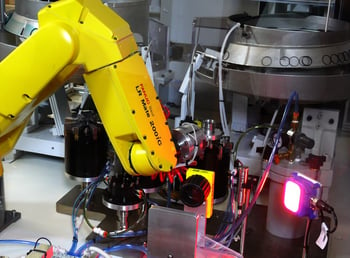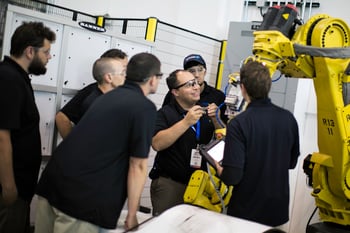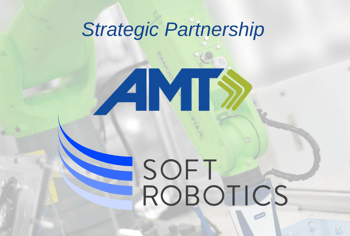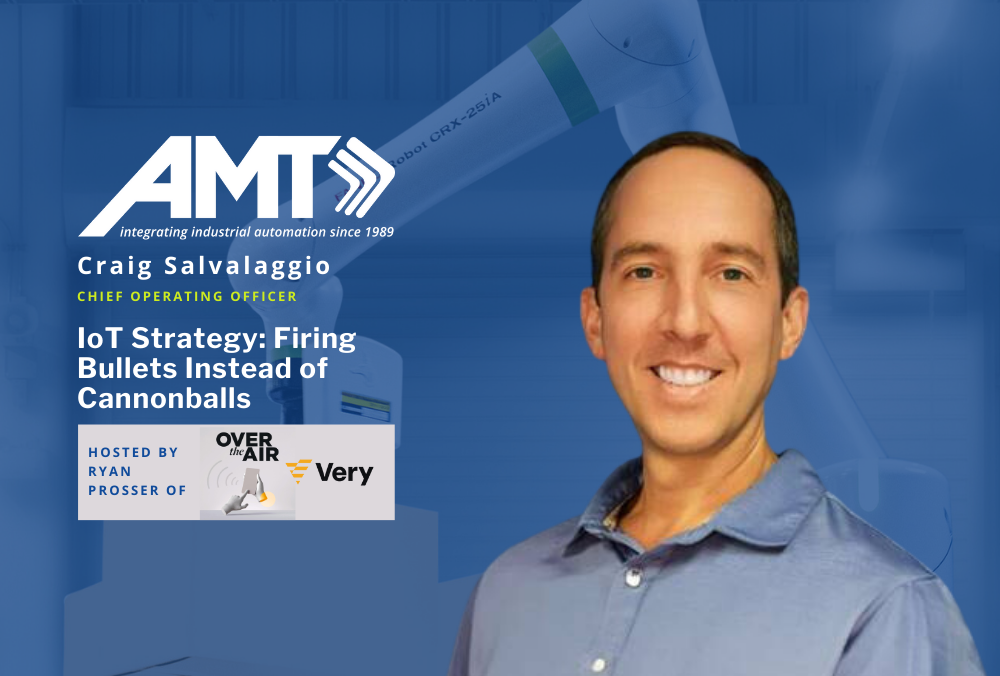Craig Salvalaggio Talks IoT Strategy with End-to-End IoT Provider
MT’s Chief Operating Officer Craig Salvalaggio was interviewed by Ryan Prosser, President and CEO of Very. Ryan interviewed Craig for episode 15 of the Over the Air podcast entitled “IoT Strategy: Firing Bullets Instead of Cannonballs.” Utilizing IoT to improve your operation is a journey; Craig gives insight into how IoT has evolved, what the possibilities are today and how AMT helps customers with their digital transformation strategy. You can listen to the podcast here or read through the transcription below.
Craig Salvalaggio started with AMT in May of 2003, nearly two decades ago. “It’s been a pleasure to be here for the last 18 years, in a founder-led organization,” said Craig. “Mike Jacobs, our founder, had a vision for creating an engineering company that would allow people to start their careers and develop full turnkey solutions for the market. Many of our applications and technologies focus on robotics and connected machines. We got started in the industry in the late 1990s when robots were being heavily adopted by the automotive companies, putting them in automotive body shops and getting into power train applications. Back then, the application set really wasn’t as defined as it is today so we were in the early stages of adoption of robotic technology.”
AMT’s Connected Device Journey
After working in automotive for several years, Craig got involved in different areas of the company and helped expand outside of the automotive market. “I got to see other applications come to life as the technology matured, became easier to use, and was more readily accepted by the end user of the manufacturing market.
“From there, I started our consulting activities within AMT and we led customers on a journey of where to start with automation. If you are looking to automate, you likely have a lot of manual processes. You’re looking at your ROI calculations, you’re looking at throughput, you’re looking at safety… Where do you start?”
AMT helps companies figure out the best place to start by creating automation roadmaps and landscapes. “We determine what automation would look like in their factories,” said Craig. “Once you have gotten through the conceptual automation and ROI numbers, the quick next step is determining how these machines are connected. We want to know What data are we collecting? What value are we providing from the data? and then How is that fed back into the machines to make them smarter? This is all part of helping companies with their IoT strategy.”
Snapshot of the Early 2000s
IoT was in its infancy in the early 2000s and Craig gave a snapshot of AMT at that time. “Back then, robots had vision systems but you had to write sophisticated code to make those vision systems complete a task. For example, automotive really pioneered standards in the industry related to how machines were built and how software was written. Those kinds of things are very valuable as you get into markets and organizations that don’t have those or are less mature with their automation strategy. Eighteen years ago, it was old-school automotive; it was a different demand, it was a different application and industrial robots were going into factories. Companies were trying to mature the technology. It was acceptable that it took a long time to configure devices and devices didn’t talk to one another. Ease of use wasn’t really a thing, whereas today, that’s a driving factor – How quickly can you get something set up? How quickly can you get the data? How can you connect to the machine?
“In the early days, you were writing specific unique software interfaces to every device; everything was custom. As the applications matured and as new industries adopted the technology, companies progressed in their thinking. In order for us to be unique and to put in more automation, we look at the technology and ask Can we make things easier? Can we write software that is better? Can we write interfaces that are intuitive to the end user, because typically it’s an operator that has to keep that machine running all day long?
“Coming back to today from where we started: now we’ve got user interfaces of three screens or less, factories where we are monitoring and collecting data, machines where we can monitor the assets and understand when the asset might fail with predictive analytics. We can understand how the machine is running overall. The technology back in the early 2000s was very centered on the industrial robot. You would have never thought that in 2021, we would be accepting that a robot and a human could be working in the same collaborative application space.”
Time Machine to 2003
What aspect of today’s automation would have been the most difficult to believe back in 2003? “I think there are two threads there,” said Craig. “One is the human collaboration with robotic technologies. Understanding that the robots would be used in such a way that they could be placed on a mobile manipulator, an AMR (autonomous mobile robot) or could be used in leveraging, in conjunction with human workers. Back in 2003, it was always, How do you get the robot in a cage so that the human is protected, including a safe stop with hard stops and the correct distances? You would have never thought that safety would be controlled by control-reliable safety circuits and that humans would be working together in the same collaborative space.
“The second piece is that I would have never believed that we could be sitting in your living room on your iPad and be able to actually collect data, look at your factory, and understand if the equipment was meeting its required uptime or OEE calculations. Here is something to understand: if you were a plant manager of an end user manufacturer, you were responsible for the equipment in that facility. We always collected data back in the historical automotive days but today, the accessibility of it and the real-time nature of it is really game changing.”
Advice to Those Just Starting Out.png?width=350&name=AMT%20Craig%20Very%20podcast(1).png)
Host Ryan said that he was excited to interview Craig because one of the things that’s unique about his background is his long tenure at AMT. When asked to recap the past 18 years at AMT and provide advice to those just starting their journey, Craig said, “One of the things that’s benefitted me beyond education and the network is learning from other people. That’s the biggest thing that I’ve gained out of my career – learning from other leaders that like to share, and like to be well educated and well read. I think by reading and understanding different authors and different topics, being ‘well read’ means you are investing in yourself and you are investing in your future.”
“The biggest piece of advice I can give is to be asking How are you investing in yourself? The second is What’s your vision? Do you have a vision, and I mean a large vision? Go back to author Jim Collins’ ‘big, hairy, audacious goal,’ and set really large goals. Anticipate: if everything went right, what is completely possible? The other piece is that everybody has a sales aspect to their role. As companies grow and they mature, as a leader of that organization, you’ve really got to understand how to keep that founder’s mentality. Really think like an owner. Be front-line obsessed with the customer and get that day-to-day feedback. When companies get too far removed from the voice of the customer, they start to solve problems that don’t really exist. You want to operate with speed and velocity, meaning you have a known trajectory. It’s a vector – there are two components of it: direction and speed. And resist that bureaucracy.
“The last thing I’ll talk about is team building. Surround yourself with the team members that are going to take you forward. We’re a highly-engineered company with a very technical audience, but there’s a piece I took recently from author Pat Lencioni’s work in which he talks about the ‘working genius’ model. It’s the idea of building teams that are well rounded. They talk about ensuring that somebody on the team has got wonder or invention, meaning that you are ideating; you’re looking at new ideas and saying, What is possible? What if we did this? What if everything was right? Then, you complement that with someone who is more of an evaluator. They discern and they galvanize. They analyze the topic to see if it’s right for the company or the group. The third piece, the really strong piece to that is implementation, meaning does someone have enablement and tenacity to get things done where you can accomplish the work? Although we have highly technical teams, it’s good to understand the working behaviors of some of those folks and make sure that you are surrounding yourself with team members that can look at the big picture and evaluate if you are doing the right thing. When we went through our IoT strategy, we went through those phases over a 10-year period. We looked at what was possible and what can we take it to. You had to fail a little bit to really learn and pick things up and get to the next step to say, What do we really want to do with this technology?
The Beginning of IoT and When Do You Implement?
Applied Manufacturing Technologies started evaluating connected machines and the connected factory back in the early 2010s. “We started looking at what IoT was,” said Craig. “I went to many conferences and nobody could really tell me what it was. They give you an architectural diagram and they can tell you you’re doing some asset monitoring but it wasn’t really clear. Nor was it clear to the folks that you’re describing it to.”
At that time, AMT took a deep look at the maturity of the technology as well as the level of understanding of their clients. “Not everybody was comfortable talking about IP addresses and understanding where things are at. We talk about data / plant security, data IP, connected machines, being vulnerable and all that stuff,” said Craig. “It can be technically confusing to the client, so part of what we learned in that journey is education. The way we did that is through firing bullets versus cannonballs. Meaning, make some small objectives before putting a lot of gunpowder into some bigger pieces. At AMT, we set up a technology council and investigated the different platforms that were out there: Siemens, Allen Bradley, and others. FANUC had a product that was in its research stage.
“We set out on a journey to understand the different technologies and their level of maturity. I can tell you that the three platforms that we picked 6-7 years ago, they currently don’t exist. They have been cannibalized by their own internal product investments. At the time, we didn’t understand the market enough to know where that technology would fit. Were we creating a product for the market? Were we trying to apply the pieces that were out there and already existed? We were trying to get all the way to the end of the goal before we really understood what technology was readily available. At the end of the day we said, Let’s do something that’s different. Let’s make something that’s unique and allows AMT to look uniquely different from other system integrators just deploying capital equipment, putting it in the market, and moving on to the next. We said, Let’s do two things. Let’s create a machine that we can connect to. Let’s minimize service calls. Let’s remote connect in and put some parameters around safety and motion, uploading and downloading programs so that we can educate the customer on what a remote connection would look like.
“We decided to tie into our own system to look at our own performance variables. We looked at our own machines. When we walked a customer through the building, I could show them that we care so much about the equipment we put in that we’re willing to put up the performance metrics in the lobby conference room to show which machines we’re monitoring. That takes it to a unique level where we’re telling the customer that we care about our equipment. And, if you care about it too, you can have access to that data and we’ll provide you that information so you can see what the status of your equipment is.
“It’s a lot about saying, Do you care about what you’re doing and can you show that? We reset our strategy and got back to the basics. We decided to pick a simple platform and technology and create a self-serving piece of equipment. This shows that we’re providing value and we care about the equipment as we’re educating our customers. We started there and took it to the event-level analytics and trend predictions once we got a little more mature.” Since then, AMT has shepherded clients through the digital transformation journey through the company’s automation consulting services.
Teams and Partners
A critical component of Applied Manufacturing Technology’s success both with IoT and as a system integrator in general has been the strategy of building and empowering strong teams. Craig said, “When building teams, you want to make sure that you are hiring for culture; they need to match the culture of the company, the speed of the company, the environment that they are working in and the leadership. At AMT, we have a very flat organizational structure. Everyone’s opinion counts and egos are checked at the door and that allows the team to fundamentally come up with good ideas and ideas that are theirs. Ideas that come from the team versus executive-driven are much more widely accepted and leveraged.
Encouraging the free flow of ideas has had some unique benefits, including many for the client. “We’ve even had an employee that’s non-technical look at our HMI screens to say if you were to walk up to this machine, could I show you how to program it in ten minutes or less just like you would any technology that’s in your home device?”
“Eighteen years ago, it was acceptable to have a very complex machine interface. Now, it’s to a point where with the labor challenges that are out there, if you want operators to use and accept the equipment, you’ve got to create a machine that’s very easy to learn and use.”
AMT extends the cooperative philosophy to other firms it considers to be partners. “Our use of partners is critical,” said Craig. “We’ve always had that philosophy because we can’t be great at everything. We’re always looking at various new technologies. We recently partnered with a company that does a vision technology that’s allowing us to solve applications with non-machine learning algorithms. It’s allowing us to find applications in different market segments that are not defined but have huge upside potential for growth. We’ve also partnered with a company that allows us to do different grasping technologies so that we can leverage robotic material handling differently in arbitrary object picking.
“The combination of those two partners is what allows us to build an ideal system that then creates an application that we can define for an industry to solve new challenges. It’s just like we’ll be sitting here 20 years from now, setting an even grander vision of what robotics can help solve in this space of industry with robots working alongside people and ensuring that companies are being more profitable and gaining market share because they can properly deploy those types of applications.”
Host Ryan asked Craig who AMT works with that is doing good work and deserves a shout-out. “One of the companies we’ve recently had an early-stage partnership working together, they have created some grasping technology that really changes the way you pick contoured objects and some of their algorithms with machine vision have been pretty interesting and would allow a new application set to be really driven forward. Soft Robotics, Inc., is a great company; take a look at their technology and you can see how that would apply to robotics and robotics applications.”
Looking Ahead with AMT
As the decade of the 2020s progresses, Craig discusses in broad strokes where AMT is headed. “Furthering the previous topic of technology partners, one of the things we’re already in the process of doing with some of our investments is looking at how we can solve some of the challenges related to box manipulation. Warehousing / logistics is a growing space and it’s not currently heavily populated with robotics. We have identified an application and a technology set that will likely allow us to solve a very difficult material handling challenge in those industries and that application market. We think by partnering with a company to help us solve some vision algorithms that we are able to define new applications within the warehousing / logistics space.”
Listen to episode 15 of the Over the Air podcast and other recent podcasts featuring Craig Salvalaggio such as: the Talking Industrial Automation podcast, The Robot Industry podcast, and the Talent 101 roundtable presentation.

